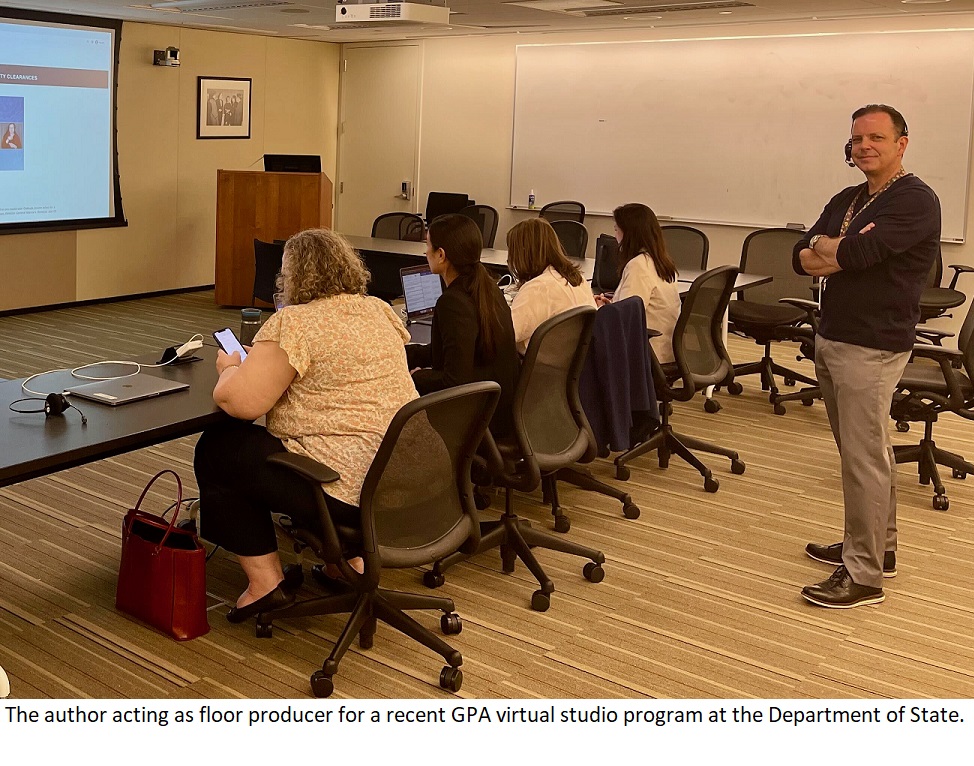Managing Risk in Live Virtual Programs, by Loren Hurst
 In advance of a recent live program I managed, my main stakeholder inquired if all was ready to go. I replied that yes, everything was prepared and was now “in God’s hands”. My very dedicated colleague didn’t seem overly amused, but nevertheless took my very cheeky comment in the spirit intended. Although my comment was clearly in jest, there was a grain of truth contained therein. For any given live program there is always the possibility that things will go wrong.
In advance of a recent live program I managed, my main stakeholder inquired if all was ready to go. I replied that yes, everything was prepared and was now “in God’s hands”. My very dedicated colleague didn’t seem overly amused, but nevertheless took my very cheeky comment in the spirit intended. Although my comment was clearly in jest, there was a grain of truth contained therein. For any given live program there is always the possibility that things will go wrong. As a live producer, I continually emphasize risk management which occurs in all three phases of program production: pre-production, program management, and post-production. Although every program is different, successful risk management is rooted in detailed organization, rapid follow up, and clear communication. Program risk can never be fully eliminated but it can be successfully anticipated and compensated for. Today I’ll identify common pitfalls and the key skills needed to minimize the chances of a live program going off the rails.
Lining up the moving parts
It is crucial to realize that live productions, once they are underway, are like machines. All the moving parts must work together and there is no time for redesigning the program once the cameras start rolling. But in reality, life intervenes and problems often arise. People are late, technology fails, and last-minute changes to scripts can all pose risks to a successful live program.
Approaches to risk management vary in each production phase but are required throughout the entire process. In pre-production, organization and follow-up are key elements. Time is on your side and occasional lapses in communication are to be expected. Moreover, the program format, messaging, and speaker line-up may still be in flux. Regardless, it is important to stay on top of tasking, set and enforce deadlines, and provide clear overall direction of preparations. In practical terms this means ensuring marketing content such as speaker bios, promotional banner images, and social media text is delivered sooner rather than later to allow for marketing time.
The few days leading up to the live program are the most important. At this point, team production roles should be firmly established, staff briefed on what their jobs are, speakers confirmed, and program content loaded. Clear communication and strict deadline enforcement is vital as all the moving parts must fit together seamlessly.
The producer's most important role immediately before a program is tight coordination of stakeholders and staff. Stakeholders often come to the producer with last-minute requests. It is crucial that the producer respond to unrealistic requests, no matter how well-intentioned, with direct, no-nonsense answers. Stakeholders do not understand the technical complexity of the livestream production environment and how request changes will impact program integrity. It is the producer’s responsibility to ensure stakeholders understand the risks that program adjustments may pose. If a request is too disruptive, the producer needs to say so.
The live program - moderator and floor producer needed
The live program itself is the easiest part of the entire process if pre-production has been properly managed. The producer now becomes the “floor producer” overseeing the technical team and making immediate decisions as surprises come up. Creative and quick thinking is sometimes required during a live production, but in most cases the floor producer simply stands back and watches the program unfold. A wise producer anticipates any sudden shifts and prepares contingency plans, as there is no time to debate courses of action when the program is live. If you are the moderator of the program you’ve produced, that adds another element of complexity and requires additional management skills. The only real solution here is to designate another team member to fill in as floor producer.
After the program is finished and congratulations are exchanged, the work is not done. Post-production is arguably the most important part of the process. It pays to recall that most views of live programs occur following the live event. In addition to metrics reporting, any well-produced program needs to have a follow up plan in place to distribute the video for maximum ongoing engagement. Best practice also involves scheduling an after-action briefing with stakeholders to go over what could be improved for future programs.
Preparation sets up success
Successful program management is ultimately about preparation, anticipation of what could go wrong, and having contingency plans in place in case the worst happens. Guessing has no place in these productions. The best producers understand that preparation allows them to stay calm, collected, and on-task during the often-stressful live production phase. Losing one’s head in the heat of the moment will always end in tears and can pose serious risks to the program itself with much larger implications for broader public diplomacy impacts.
Meticulous preparation has another important benefit. It gives the producer confidence and flexibility as the program unfolds. Live programs always take on a life of their own and a well-prepared program can lead into unforeseen and fortuitous benefits driven by speaker exchanges. Ironically, detailed planning gives the producer options to, in producer-speak, “let it play”. Good, spontaneous conversation is infectious, entertaining, and greatly contributes to meaningful audience engagement.
*************************************
Loren Hurst produces, directs, and moderates live stream and broadcast media programs in the U.S. State Department’s Bureau of Global Public Affairs.